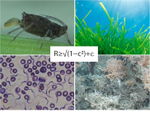
MACAYA-SANZ David
Recommendations: 0
Review: 1
Review: 1

The discernible and hidden effects of clonality on the genotypic and genetic states of populations: improving our estimation of clonal rates
How to estimate clonality from genetic data: use large samples and consider the biology of the species
Recommended by Myriam Heuertz based on reviews by David Macaya-Sanz, Marcela Van Loo and 1 anonymous reviewerPopulation geneticists frequently use the genetic and genotypic information of a population sample of individuals to make inferences on the reproductive system of a species. The detection of clones, i.e. individuals with the same genotype, can give information on whether there is clonal (vegetative) reproduction in the species. If clonality is detected, population geneticists typically use genotypic richness R, the number of distinct genotypes relative to the sample size, to estimate the rate of clonality c, which can be defined as the proportion of reproductive events that are clonal. Estimating the rate of clonality based on genotypic richness is however problematic because, to date, there is no analytical, nor simulation-based, characterization of this relationship. Furthermore, the effect of sampling on this relationship has never been critically examined.
The paper by Stoeckel, Porro and Arnaud-Haond [1] contributes significantly to the characterization of the relationship between rate of clonality and genetic and genotypic parameters in a population. The authors use an extensive individual-based simulation approach to assess the effects of rate of clonality (fully sexual, fully clonal and a range of intermediate levels of clonality, i.e., partial clonality) on genetic and genotypic parameters, considering variable population size, sample size, and numbers of generations elapsed since population initiation. Based on their simulations, they derive empirical formulae that link for the first time the rate of clonality to the genotypic richness and to the size distribution of clones (genotypic parameters), as well as to the population inbreeding coefficient and to a metric of linkage disequilibrium (genetic parameters). They then use the simulated data to assess the accuracy of their predictions. In a second phase, the authors use a Bayesian supervised learning algorithm to estimate rates of clonality from the simulated data.
The authors show that the relationship between rate of clonality and genotypic richness is not linear: genotypic richness decreases slowly with increasing clonality, a large drop in genotypic richness is only seen for rates of clonality ≥ 0.90. Genetic parameters are only sensitive to high rates of clonality. The practical implications of these results are that genotypic and genetic parameters can complement each other for the estimation of rates of clonality, with genotypic parameters most useful throughout most of the range of clonality values and with genetic parameters complementing them meaningfully at higher values. The most meaningful practical result of the paper is the demonstration of sampling bias on the estimation of genotypic richness. Commonly used population sample sizes in population genetics studies (n ≤ 50) lead to great overestimation of genotypic richness, which consequently leads to a severe underestimation of the rate of clonality in most systems, irrespectively of whether they have reached stationary equilibrium. Only in small populations, these effects are attenuated.
Biologists interested in the estimation of the rate of clonality will find this paper highly useful to design their sampling, and to choose their statistics for inference in a meaningful way. This paper also calls for a careful reappraisal of previously published works that infer rates of clonality from genetic data, and highlights the prime importance of complementary information on species life history data for a correct understanding of partial clonality.
References
[1] Stoeckel, S., Porro, B., and Arnaud-Haond, S. (2019). The discernible and hidden effects of clonality on the genotypic and genetic states of populations: improving our estimation of clonal rates. ArXiv:1902.09365 [q-Bio] v4 peer-reviewed and recommended by Peer Community in Evolutionary Biology. Retrieved from http://arxiv.org/abs/1902.09365v4